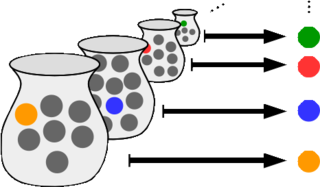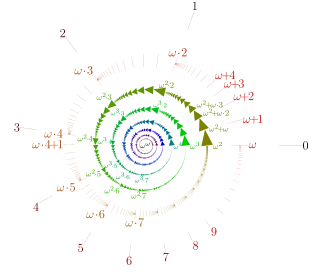
In mathematics, the axiom of choice, abbreviated AC or AoC, is an axiom of set theory equivalent to the statement that a Cartesian product of a collection of non-empty sets is non-empty. Informally put, the axiom of choice says that given any collection of sets, each containing at least one element, it is possible to construct a new set by choosing one element from each set, even if the collection is infinite. Formally, it states that for every indexed family of nonempty sets, there exists an indexed set such that for every . The axiom of choice was formulated in 1904 by Ernst Zermelo in order to formalize his proof of the well-ordering theorem. The axiom of choice is equivalent to the statement that every partition has a transversal.
In mathematics, a topological space is, roughly speaking, a geometrical space in which closeness is defined but cannot necessarily be measured by a numeric distance. More specifically, a topological space is a set whose elements are called points, along with an additional structure called a topology, which can be defined as a set of neighbourhoods for each point that satisfy some axioms formalizing the concept of closeness. There are several equivalent definitions of a topology, the most commonly used of which is the definition through open sets, which is easier than the others to manipulate.

Transfinite induction is an extension of mathematical induction to well-ordered sets, for example to sets of ordinal numbers or cardinal numbers. Its correctness is a theorem of ZFC.
In mathematics, the well-ordering theorem, also known as Zermelo's theorem, states that every set can be well-ordered. A set X is well-ordered by a strict total order if every non-empty subset of X has a least element under the ordering. The well-ordering theorem together with Zorn's lemma are the most important mathematical statements that are equivalent to the axiom of choice. Ernst Zermelo introduced the axiom of choice as an "unobjectionable logical principle" to prove the well-ordering theorem. One can conclude from the well-ordering theorem that every set is susceptible to transfinite induction, which is considered by mathematicians to be a powerful technique. One famous consequence of the theorem is the Banach–Tarski paradox.

Zorn's lemma, also known as the Kuratowski–Zorn lemma, is a proposition of set theory. It states that a partially ordered set containing upper bounds for every chain necessarily contains at least one maximal element.
In topology, a discrete space is a particularly simple example of a topological space or similar structure, one in which the points form a discontinuous sequence, meaning they are isolated from each other in a certain sense. The discrete topology is the finest topology that can be given on a set. Every subset is open in the discrete topology so that in particular, every singleton subset is an open set in the discrete topology.
In mathematics, Tychonoff's theorem states that the product of any collection of compact topological spaces is compact with respect to the product topology. The theorem is named after Andrey Nikolayevich Tikhonov, who proved it first in 1930 for powers of the closed unit interval and in 1935 stated the full theorem along with the remark that its proof was the same as for the special case. The earliest known published proof is contained in a 1935 article by Tychonoff, "Über einen Funktionenraum".
In set theory, Zermelo–Fraenkel set theory, named after mathematicians Ernst Zermelo and Abraham Fraenkel, is an axiomatic system that was proposed in the early twentieth century in order to formulate a theory of sets free of paradoxes such as Russell's paradox. Today, Zermelo–Fraenkel set theory, with the historically controversial axiom of choice (AC) included, is the standard form of axiomatic set theory and as such is the most common foundation of mathematics. Zermelo–Fraenkel set theory with the axiom of choice included is abbreviated ZFC, where C stands for "choice", and ZF refers to the axioms of Zermelo–Fraenkel set theory with the axiom of choice excluded.

In mathematics, general topology is the branch of topology that deals with the basic set-theoretic definitions and constructions used in topology. It is the foundation of most other branches of topology, including differential topology, geometric topology, and algebraic topology.
Reverse mathematics is a program in mathematical logic that seeks to determine which axioms are required to prove theorems of mathematics. Its defining method can briefly be described as "going backwards from the theorems to the axioms", in contrast to the ordinary mathematical practice of deriving theorems from axioms. It can be conceptualized as sculpting out necessary conditions from sufficient ones.
In mathematics, two sets or classes A and B are equinumerous if there exists a one-to-one correspondence (or bijection) between them, that is, if there exists a function from A to B such that for every element y of B, there is exactly one element x of A with f(x) = y. Equinumerous sets are said to have the same cardinality (number of elements). The study of cardinality is often called equinumerosity (equalness-of-number). The terms equipollence (equalness-of-strength) and equipotence (equalness-of-power) are sometimes used instead.

The axiom of countable choice or axiom of denumerable choice, denoted ACω, is an axiom of set theory that states that every countable collection of non-empty sets must have a choice function. That is, given a function with domain such that is a non-empty set for every , there exists a function with domain such that for every .
In mathematics, the axiom of dependent choice, denoted by , is a weak form of the axiom of choice that is still sufficient to develop much of real analysis. It was introduced by Paul Bernays in a 1942 article in reverse mathematics that explores which set-theoretic axioms are needed to develop analysis.
In mathematics, a set A is Dedekind-infinite if some proper subset B of A is equinumerous to A. Explicitly, this means that there exists a bijective function from A onto some proper subset B of A. A set is Dedekind-finite if it is not Dedekind-infinite. Proposed by Dedekind in 1888, Dedekind-infiniteness was the first definition of "infinite" that did not rely on the definition of the natural numbers.
In the foundations of mathematics, Morse–Kelley set theory (MK), Kelley–Morse set theory (KM), Morse–Tarski set theory (MT), Quine–Morse set theory (QM) or the system of Quine and Morse is a first-order axiomatic set theory that is closely related to von Neumann–Bernays–Gödel set theory (NBG). While von Neumann–Bernays–Gödel set theory restricts the bound variables in the schematic formula appearing in the axiom schema of Class Comprehension to range over sets alone, Morse–Kelley set theory allows these bound variables to range over proper classes as well as sets, as first suggested by Quine in 1940 for his system ML.
In the mathematical discipline of set theory, there are many ways of describing specific countable ordinals. The smallest ones can be usefully and non-circularly expressed in terms of their Cantor normal forms. Beyond that, many ordinals of relevance to proof theory still have computable ordinal notations. However, it is not possible to decide effectively whether a given putative ordinal notation is a notation or not ; various more-concrete ways of defining ordinals that definitely have notations are available.

In set theory, the axiom of limitation of size was proposed by John von Neumann in his 1925 axiom system for sets and classes. It formalizes the limitation of size principle, which avoids the paradoxes encountered in earlier formulations of set theory by recognizing that some classes are too big to be sets. Von Neumann realized that the paradoxes are caused by permitting these big classes to be members of a class. A class that is a member of a class is a set; a class that is not a set is a proper class. Every class is a subclass of V, the class of all sets. The axiom of limitation of size says that a class is a set if and only if it is smaller than V—that is, there is no function mapping it onto V. Usually, this axiom is stated in the equivalent form: A class is a proper class if and only if there is a function that maps it onto V.
An approach to the foundations of mathematics that is of relatively recent origin, Scott–Potter set theory is a collection of nested axiomatic set theories set out by the philosopher Michael Potter, building on earlier work by the mathematician Dana Scott and the philosopher George Boolos.

In set theory, an ordinal number, or ordinal, is a generalization of ordinal numerals aimed to extend enumeration to infinite sets.
This is a glossary of terms and definitions related to the topic of set theory.






















